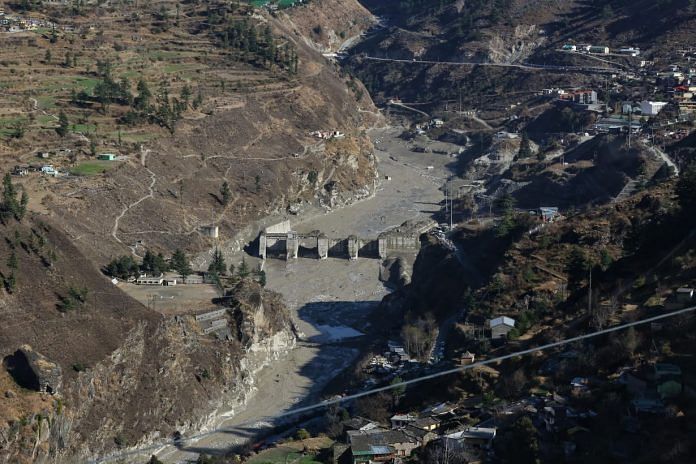New Delhi: The central government Wednesday told the Supreme Court that the recent flood in Uttarakhand had nothing to do with the ongoing Rs 12,000-crore Char Dham road project — the Modi government’s ambitious plan to improve road connectivity to the Hindu pilgrimage sites of Yamunotri, Gangotri, Kedarnath and Badrinath.
The oral submission was made in response to a letter submitted by Ravi Chopra, chairman of the court-appointed High Powered Committee that attributed the flash flood on 7 February to the road project.
The SC was hearing an ongoing case between a Dehradun-based NGO, Citizens for Doon, and the central government on the Char Dham project. The NGO has raised environmental concerns regarding the project as it involves hill- and tree-cutting for a new highway and widening of existing roads.
The court adjourned the case for two weeks and has sought a response from the defence ministry to the charges mentioned in the letter.
ThePrint reached Chopra to ask about the letter but he refused to comment on the matter.
Also read: Uttarakhand flood puts focus on Rs 12,000-cr Char Dham project, ministry awaits SC order
Reducing width can cause serious safety hazard: Road ministry
The Char Dham project has come under the Supreme Court’s scanner over environmental concerns including the width of the road.
In a written affidavit submitted to the SC Wednesday, the Union Ministry of Road, Transport and Highways said that except for small stretches, hill cutting has been carried out on most of the stretches of the 825-km project, according to the old formation width of 12 metres.
Therefore, it noted, attempting to reduce the width of the roads, as directed by the SC in an earlier order, will cause a safety hazard.
“It is submitted that in a particular sanctioned project, due to various operational difficulties, hill cutting and laying down of a tarred road is often not carried out simultaneously and/or in a linear form. Thus, reducing the width of the road to 5.5 mts in those unfinished stretches at this stage would cause a serious road safety hazard,” the ministry said in its affidavit, a copy of which was accessed by ThePrint.
On 8 September 2020, the SC had ordered that the road width on the entire Char Dham route should be 5.5 metres, in accordance with the standards laid down by the road ministry’s March 2018 circular.
This was also recommended by the High Powered Committee, which said that no new hill cutting should be done in all the ongoing and proposed projects till the HPC has reviewed the Rapid Environment Impact Assessment report.
The ministry had earlier followed its 2012 order based on which the road width of a two-lane road with paved shoulder was fixed at 10 metres.
Also read: Uttarakhand flash flood — 53 bodies recovered so far as rescue operations continue
674 km of road project involve strategic roads
In its affidavit, the ministry has also stated that out of the total length of 825 km, only 151 km consist of non-strategic roads. The remaining 674 km are strategically important because they are feeder roads to the India-China border roads, which are under the defence ministry’s control.
In January, the defence ministry had noted that there will be serious repercussions on the defence of the country and its security interests if the road width was reduced from 10 metres.
The ministry had said that the security of the country was in “jeopardy especially in the background of today’s sensitive situation existing at the Chinese border”. Furthermore, it added that in view of the “recent face-off with Nepal on the Lipulekh side in 2020, all these sectors are highly sensitive” and “critical for movement of security forces, deployment pattern, and mobilization in case of emergency”.
Prime Minister Narendra Modi had laid the foundation stone of the project in 2016 and the first deadline to complete it was March 2019. The deadline has been extended twice since then.
Also read: Caught between SC & Centre, 24 Uttarakhand hydel projects stuck on paper after 2013 floods




That may be true in a narrow, technical sense. However, just as the large number of hydel projects are straining the ecology of Uttaranchal, so will the Chardham highway project. The ministry of environment has become a doe in recent years when it needs to remain a tiger.